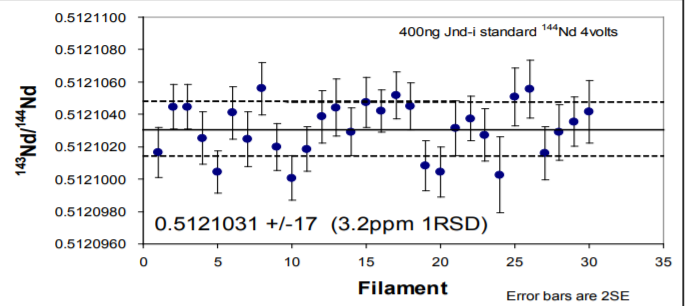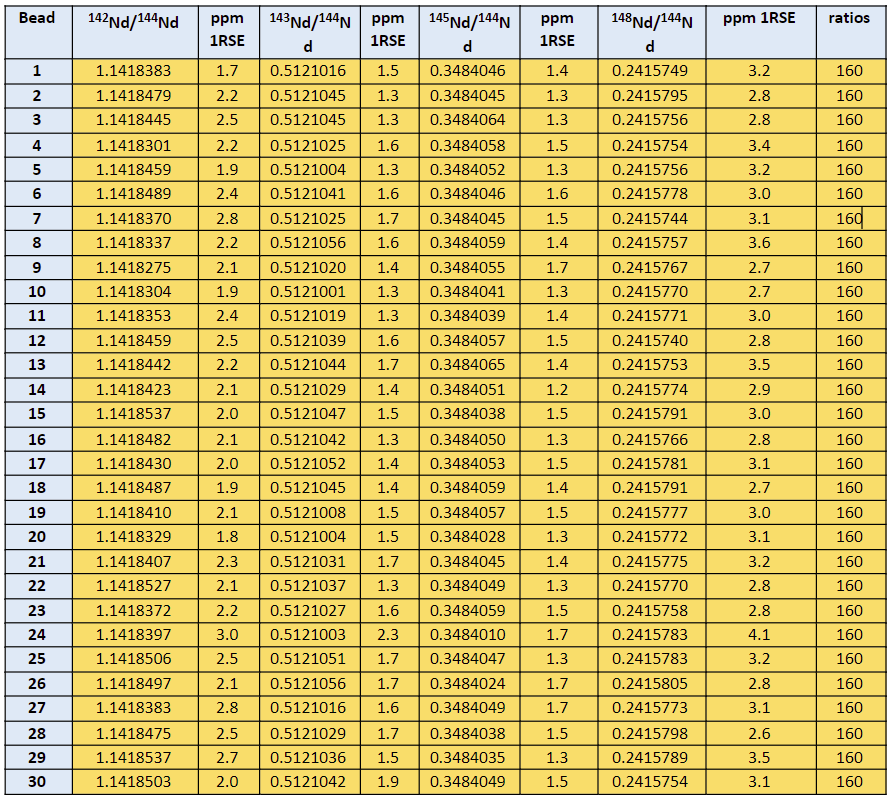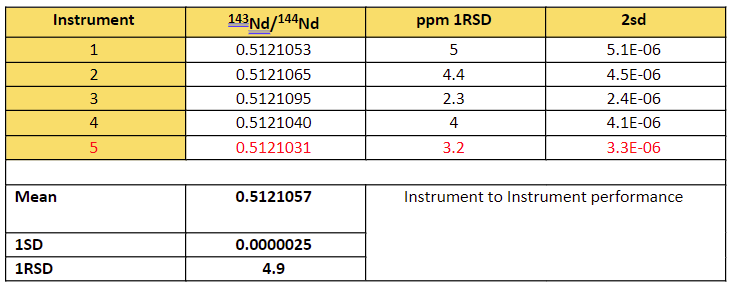Introduction
Neodymium together with strontium isotope ratio measurements are the benchmark analyses that define the ultimate precision and accuracy of isotope ratio measurements that Thermal Ionization mass spectrometers are capable of. The mass fractionation which occurs during thermal ionization can be compensated for using the exponential mass fractionation law. This can lead to single analysis precisions of better than 1ppm 1RSD given a sufficiently large ion beam and long analysis time. Reproducibility of measurement however, is governed by instrumental factors. These include:
- Amplifier gain stability
- Noise stability
- Ion focussing reproducibility
- Collector efficiency
- HT and magnetic field stability
- Size of peak flatness.
- Amplifier response
For the measurements presented here, a multidynamic analysis protocol was used. This cancels out the amplifier and collector efficiency variables (see below), but all other variables are possible sources of error. The analytical goal is to ensure that instrument effects are negligible, which would ultimately result in the reproducibility of the measurement being the same as the precision of an individual measurement.
Analytical Protocol
400ng of the JNd-i isotope standard was deposited onto the side filament of a degassed triple Re filament assembly. 30 analyses were made in two turrets, Turret 1, 10 samples, Turret 2 20 samples.

A 3 mass-jump multidynamic sequence (Table 1) was used. The routine corrects for collector efficiency and gain variations, it does this by measuring the normalizing ratio (in this case 146Nd/144Nd = 0.7219) on the same collectors as the isotope ratio of interest . In this example the 143Nd/144Nd in cycle 1 and 2 are fractionation corrected using 146Nd/144Nd in cycle 3. 145Nd/144Nd in cycle 2 and 3 are fractionation corrected using 146Nd/144Nd in cycle 3. 142Nd/144Nd in cycle 1 is fractionation corrected using 146Nd/144Nd in cycle 3. 148Nd/146Nd in cycle 3 is fractionation corrected using 146Nd/144Nd in cycle 1. 148Nd/144Nd is simply derived by multiplying 148Nd/146Nd with 146Nd/144Nd = 0.7219
Analyses were made with a 144Nd intensity of 4 Volts (4e11 amps). Samples were not run to exhaustion. Data were collected in 8 blocks of 20 cycles. Each integration was for 10 seconds and so one complete cycle comprised 30 seconds of measurement. Mass fractionation was corrected using an exponential law using 146Nd/144Nd = 0.7219.
Results
Table 2 gives the Nd isotope ratio results for all 30 measurements. Figure 1 provides a graphical representation of the filament to filament variation in 143Nd/144Nd.
The measured 143Nd/144Nd for the JNd-i standard is 0.5121031. The external precision (1σ) taken over all 30 measurements is 3.2ppm for 143Nd/144Nd internal precision is typically 1.5ppm (1RSE). No discernible trend can be seen in Figure 1 . Instrumental errors can be considered to have a contribution of about 1ppm, though this may also include a small contribution from non corrected mass fractionation.



Instrument to Instrument performance
Table 3 presents the results of 143Nd/144Nd measurements on four instruments during installation in 2011, together with the data in this report (red). The mean reproducibility for each instrument is typically 3 to 4ppm. The mean isotopic composition for all 5 instruments is 0.5121057 +/- 4.9ppm. This is comparable to that on any one instrument. The data show that each instrument is set-up in the same way and that there are no significant biases between each instrument.

Summary
Phoenix analyses 143Nd/144Nd at 3 to 4 ppm reproducibility 1RSD. Instrument to instrument performance is extremely consistent.
Download Application Note
Download the complete Application Note: High Precision Nd on Phoenix